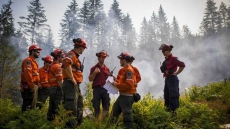A team of geological researchers is challenging claims that some of the earliest forms of known life existed in northern Labrador.
The argument that a rocky outcrop showed evidence of life going back 3.95 billion years was presented by Japanese scientists in 2017 using isotopic evidence, sometimes called "chemofossils."
A team of scientists led by Martin Whitehouse, a professor of geosciences at the Swedish Museum of Natural History, agrees the ancient signatures of life are present in the Torngat mountain region.
However, the Swedish-funded research concludes the rocks that surrounded the evidence of life are much younger than the Japanese research indicates — meaning the life itself is also likely hundreds of millions of years younger.
Whitehouse's team looked at the same outcrops as the Japanese but came up with a differing mapping of the geology.
The rocks being examined are in the Saglek Bay area, at the southern end of the Torngat Mountains National Park, in an area where some of the oldest continental crusts are exposed to the surface.
The findings were published in the journal, Precambrian Research, in January.




